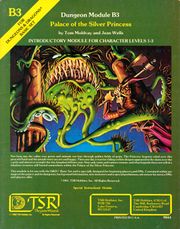[ Palace of the Silver Princess]

|
| System:
|
Dungeons and Dragons 1e
|
| Levels:
|
1 – 3
|
| Author:
|
Tom Moldvay. Jean Wells
|
| Publisher:
|
TSR
|
| Item Code:
|
9044
|
| Publication Date:
|
1981
|
| Format:
|
Paperback
|
| Page Count:
|
32
|
| ISBN-10:
|
935696-31-8
|
|
| Product Blurb
|
| Not long ago, the valley was green and animals ran free through golden fields of grain. The Princess Argenta ruled over this peaceful land and the people were secure and happy. Then one day, a warrior riding a white dragon appeared in the skies over the castle, and almost overnight the tiny kingdom fell into ruin. Now only ruins and rumors remain, and what legends there are tell of a fabulous treasure still buried somewhere within the Palace of the Silver Princess.
|
This text is quoted from promotion material. Text and images are copyrighted by the original publisher.
|
Plot Summary[edit]
The module has been described as a low-level scenario, which involves the legends surrounding a ruined palace, a white dragon, and a giant ruby. The player characters encounter evil creatures that have taken over the palace. The plot of Palace of the Silver Princess revolves around a country frozen in time by a strange red light. The only seemingly unaffected location and the apparent source of the glow is the royal palace. The adventurers must restore the flow of time and save the country.
Publication History[edit]
In 1980, Jean Wells, the only woman in TSR's design department, was assigned to write an adventure for the "B" (Basic) series that would teach new players how to play D&D using rules for the D&D Basic Set. This module would be unique as it was the first TSR adventure authored by a female designer. She consulted her editor, Ed Sollers, about every detail, and the result was B3 Palace of the Silver Princess. In keeping with the design of the first D&D module of the "B" series, B1 In Search of the Unknown by Mike Carr, Wells left several rooms and areas of the module incomplete so that players could customize those areas themselves. As she related, "I was trying to show the players that there was more to a 'dungeon' than just the building. I didn't complete the palace, trying to show them this map could be a mini base map for their game. The players could discover the part of the dungeon that had been caved in wasn't any longer and the DM could expand it. I was assuming that they were trying to learn to set up their own world and I was trying to help." During the editorial process, Wells wanted to replace artwork by Erol Otus that had transformed her new three-headed monsters called "ubues" into hermaphrodites with the heads of TSR staffers and management. However, she was told that it was too late, since replacing the artwork would cause unreasonable printing delays. Original "orange version" On the eve of publication, when the cartons of printed modules arrived at TSR headquarters ready for shipping, someone in TSR's upper management objected strongly to the module. Some sources state that the objectionable content was four pieces of artwork by Erol Otus and Laura Roslof that were too overtly sexual. These included "The Illusion of the Decapus" by Laura Roslof, wife of Jim Roslof, in which a woman tied up by her own hair was being tortured by demonic-looking figures. Author Jim McLauchlin points out that at the time, some people were claiming that D&D promoted devil worship, and during this 'Satanic Panic', "the image posed a very real threat to the company's bottom line." However, Frank Mentzer later claimed that the objectionable art was rather tame compared to that released in some other products of the time, and that the real reason was the Erol Otus caricatures of TSR executives in the illustration of the ubues. Other people employed at TSR at the time agree that management found this particular illustration objectionable, but disagree as to who was being caricatured. Lawrence Schick, then the head of the creative department, believes that Otus was portraying fellow creative staff members. Editor/game developer Kevin Hendryx states that it was recently terminated employees that were illustrated, and that "upper management was very sensitive about mutiny in the ranks at the time and took all these perceived slurs or snoot-cockings as an insult and a challenge." Wells herself related that another member of the design department complained to senior executive Kevin Blume, and that subsequently she and her editor, Ed Sollers, were called into Kevin Blume's office and asked to explain why a module designed for a younger audience contained S&M. The end result was that the entire print run of 5,000–10,000 copies of what became known as the "orange version" — because of its orange cover design — was destroyed. The copies already sent out to stores were ordered to be recalled, and that night the personal copies handed out earlier that day were removed from the employees' desks; the few copies employees had taken home that night were not confiscated, but the rest ended up in a Lake Geneva landfill, along with all the copies TSR could reclaim from those already shipped out. The entire module was subsequently rewritten by Tom Moldvay, who changed the plot, replaced all of Wells' new monsters with standard monsters from the Monster Manual, and removed the empty areas. In addition, the four contentious pieces of artwork, as well as many others, were replaced. The new version was then released with a green cover, with writing credit given to both Moldvay and Wells, although the new version contained little of Wells' original content other than the setting.
Template:Publication Breadcrumb/1e Adventures

